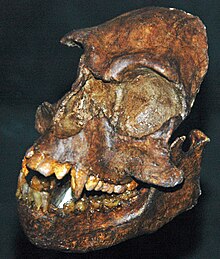Pliopithecoidea
| Pliopithecoidea Temporal range: Middle Miocene–Late Miocene |
|
|---|---|
 |
|
| Epipliopithecus skull | |
| Scientific classification | |
| Kingdom: | Animalia |
| Phylum: | Chordata |
| Class: | Mammalia |
| Order: | Primates |
| Suborder: | Haplorhini |
| Parvorder: | Catarrhini |
| Superfamily: | †Pliopithecoidea |
| Families, subfamilies & unplaced genera | |
|
Dionysopithecidae |
|
Dionysopithecidae
Pliopithecidae
Crouzeliinae
Genus Paidopithex
Genus Krishnapithecus
Pliopithecoidea is an extinct superfamily of catarrhine primates that inhabited Asia and Europe during the Miocene. Although they were once a widespread and diverse group of primates, the Pliopithecoids have no living descendants.
The first fossil specimens attributed to Pliopithecoidea were discovered by Édouard Lartet in Sansan, France in 1837. These fossils were later referenced by Henri Marie Ducrotay de Blainville in 1839, who named the type species Pliopithecus antiquus. A second species, Pliopithecus platyodon, was discovered in Switzerland by Biedermann in 1863. Following this, a small number of other pliopithecoid species were described from fossil collections found in France, Germany, and Poland.
In the mid-twentieth century, paleontologists Johannes Hürzeler and Helmuth Zapfe reinvigorated interest in the pliopithecoids with a series of publications in which they named a number of new species, including Pliopithecus vindobonensis, which consists of the most complete cranial and post-cranial pliopithecoid specimens ever discovered. Based on their size, and some superficial similarities to modern day gibbons, Zapfe suggested that pliopithecoids were ancestral to the Hylobatidae lineage.
With the discovery of more European pliopithecoid fossils in the mid to late 1970s, and subsequent discovery of pliopithecoid fossils in China, the idea that pliopithecoids were ancestral to gibbons fell out of favor. Today, most paleontologists agree that pliopithecoids hold a basal position in the catarrhine family tree. As such, pliopithecoids represent something similar to the common ancestor of Old World monkeys and apes.
A femur discovered in Eppelsheim and given the Genus name Paidopithex was for many years controversial, as its large size compared to Pliopithecoids led to suggestions that it was instead related to the Dryopithecini. A lack of femurs for Dryopithecini meant that the suggestion was not ruled out for many years, but in 2002 work by Köhler et al comparing it to a recently discovered Dryopithecus laietanus skeleton showed that it was very different from the Dryopithecini. However, Köhler felt unable to definitely place Paidopithex in the Pliopithecoid superfamily, stating it was either an unusually large Pliopithecoid (estimated bodyweight 22 kg) or could be the sole known species of a separate superfamily.
...
Wikipedia
